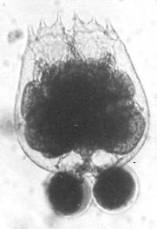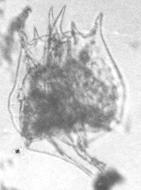back to 40 a. - Back to content
40 b. Lorica soft, dorsal and ventral plates not
distinguishable. Size 150-300 μm. Food unicellular
algae: Cyanophyta, Dunaliella. In brackish and
inland salt water. Planktonic. Two strains existing:
Brachionus rotundiformis or small (S-type) rotifers
with a lorica length of 100 to 210 μm (average 160 mm)
show pointed spines and Brachionus plicatilis or
large (L-type) rotifers with lorica length ranging
from 130 to 340 μm (average 239 mm) has obtuse angled
spines. The S-type has an optimal growth at 28-35°C,
while the L-type reaches its optimal growth at 18-25°C
(Lavens and Sorgeloos, 1996). Small tropical forms are
usually S-forms, like the "p-ot" marine strain from the
Philippines (Kotani, 2005c). The average size of lorica
in Laguna de Bay is 220 μm, which suggest the L-form
(Br. plicatilis), however, the pointed spines on lorica
suggest the strain to be the S-form (Br. rotundiformis).
- Laguna de Bay (during periods with high salinity),
Pasig River, (culture with water from) Manila Bay , Taal Lake.
Brachionus plicatilis, MÜLLER 1787 (L-form) and
Brachionus rotundiformis (TSCHUGUNOFF, 1921) (S-form)
[1941a, 1974, 1984a, 2005c, 2009a, 2011a (plicatilis)]
B. plicatilis from Laguna de Bay
QUADRIDENTATUS GROUP
41a. Lorica smooth or faintly striped. Foot opening tube-shaped.
Body very broad and flat. Median anterior spines long,
more or less curved. Lorica tuberculate, with regular
pattern of facets. Highly polymorphic.
§ Posterior spines absent, lorica posterior rounded
(form cluniorbicularis, SKORIKOV, 1894)
§§ Posterior spines present: short, length less than 1/3 of
lorica (form brevispinus, EHRENBERG, 1832,
form rhenanus, (LAUTERBORN, 1893))
§§§ Posterior spines present: long, length more than 1/3 of
lorica (form longispinosus, KOEPPEL, 1940).
Size of lorica 150-400 µm. Planktonic, also littoral between
plants. In lakes, reservoirs, ponds, ricefields and running
water. Also in brackish and saline water. Indicator of
mesotrophic waters (Sládeček 1983). Very common.- Laguna de Bay, Pasig River, Calamba River, IRRI rice field,
Taal lake.Brachionus quadridentatus, (HERMAN, 1783)
(syn. Brachionus bakeri)
[1941a, 1978a+b, 1980, 1984a, 1986a, 1999,
2001a, 2009, 2011a+b+c]
B. quadridentatus from Laguna de Bay
41 b. Lorica stiff, clearly granulated and striped.
With basal plate set off from the dorsal plate.
Lateral anterior spines longer than the median
spines. Spine length variable. Size 180-550 μm.
Probably littoral.- IRRI rice field.
Brachionus bidentatus ANDERSON 1889
(syn. Brachionus bidentata)[1999]
41 c. Lorica very strong, clearly granulated and sometimes with
fields. With basal plate. Foot opening not tube shaped,
with 3 spines. Median anterior spines short. Posterior
corners without spines. Size up to 340 μm. Semiplanktonic.
Indicator of mesotrophic waters (Sládeček 1983).- In ponds, lakes and rivers (Pasig River). Also in brackish and saline water.
Brachionus leydigii, (COHN, 1862)
to 42a

